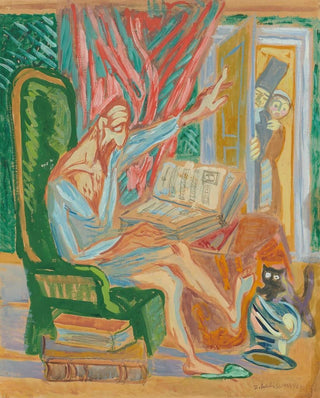Art print | Don Quixote in an armchair - Zygmunt Waliszewski Source: Reproduction | Don Quichotte dans un fauteuil - Zygmunt Waliszewski


View from behind

Frame (optional)
"Don Quichotte dans un fauteuil" art print by Zygmunt Waliszewski is a captivating representation of Cervantès' famous character. This piece evokes not only Don Quichotte's chivalrous spirit but also the psychological depth emanating from the literary hero. In this work, Waliszewski manages to capture the very essence of the quest for greatness and dreams, immersing the viewer in a universe rich in emotion. Through his brushstrokes, he invites us to explore themes of illusion and reality, encouraging reflection on our own perception of the world.
Style and uniqueness of the art print
Waliszewski stands out with his unique approach to portraiture, where every detail is carefully crafted to convey a particular atmosphere. In "Don Quichotte dans un fauteuil," the choice of colors and textures evokes a bittersweet melancholy, illustrating the duality between dream and disillusion. The character, seated in an armchair, appears lost in thought, while his gaze fixed on the horizon, symbolizing his unreachable aspirations. Light plays a crucial role in this art print: it sculpts forms and enhances emotions, creating a play of shadows and highlights that deepens the image. This technique, combined with a realistic style, allows Waliszewski to forge an intimate connection between the subject and the viewer, making the art print even more captivating.
The artist and his influence
Zygmunt Waliszewski, a 20th-century Polish artist, made his mark with an innovative approach to painting. Influenced by the realist movement, he incorporated elements of romanticism into his works, which helped him stand out in the artistic landscape. His passion for literature, especially for Cervantès' works, fueled his artistic creation and enabled him to bring iconic characters to life through his art. Waliszewski does not merely reproduce scenes; he reinvents them, enriching them with his own vision of the world. His influence endures today, inspiring many contemporary artists to explore the links between literature and

Matte finish

View from behind

Frame (optional)
"Don Quichotte dans un fauteuil" art print by Zygmunt Waliszewski is a captivating representation of Cervantès' famous character. This piece evokes not only Don Quichotte's chivalrous spirit but also the psychological depth emanating from the literary hero. In this work, Waliszewski manages to capture the very essence of the quest for greatness and dreams, immersing the viewer in a universe rich in emotion. Through his brushstrokes, he invites us to explore themes of illusion and reality, encouraging reflection on our own perception of the world.
Style and uniqueness of the art print
Waliszewski stands out with his unique approach to portraiture, where every detail is carefully crafted to convey a particular atmosphere. In "Don Quichotte dans un fauteuil," the choice of colors and textures evokes a bittersweet melancholy, illustrating the duality between dream and disillusion. The character, seated in an armchair, appears lost in thought, while his gaze fixed on the horizon, symbolizing his unreachable aspirations. Light plays a crucial role in this art print: it sculpts forms and enhances emotions, creating a play of shadows and highlights that deepens the image. This technique, combined with a realistic style, allows Waliszewski to forge an intimate connection between the subject and the viewer, making the art print even more captivating.
The artist and his influence
Zygmunt Waliszewski, a 20th-century Polish artist, made his mark with an innovative approach to painting. Influenced by the realist movement, he incorporated elements of romanticism into his works, which helped him stand out in the artistic landscape. His passion for literature, especially for Cervantès' works, fueled his artistic creation and enabled him to bring iconic characters to life through his art. Waliszewski does not merely reproduce scenes; he reinvents them, enriching them with his own vision of the world. His influence endures today, inspiring many contemporary artists to explore the links between literature and






